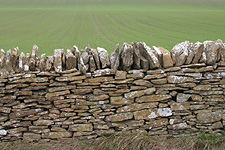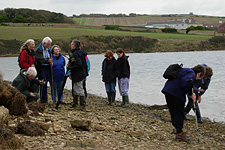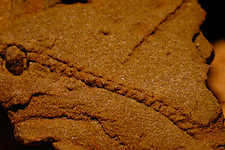Trip ReportAfter a very wet week we were relieved to be walking out of the Elm Tree car park in fine weather. Reaching the fields above the Fleet the first birds we saw were a group of 3 or 4 Stonechats, relatively common breeding birds in the area but likely to be passage migrants at this time of year. The fields were full of Skylarks and Meadow Pipits which were also likely to be passing through, as most probably were the flock of Wood Pigeons that flew over us.Across the valley an agitated flock of Rooks were found to be mobbing a Buzzard, which flew towards us to land in a tree within 'scoping distance. On the other side of the path a Hare suddenly got up and ran across the field. |
| We met some walkers coming the other way who informed us that there were some deer in the next field. Sure enough as we got over the brow of the hill we could see a group of 10 or so Roe Deer stood watching us watching them. Through the telescope we could see that one was a buck with a good set of antlers. |
© Bryony Ford
Drystone wall |
© Jenny Sloan/Nature Portfolio
Looking for fossils on the beach at Herbury |
Half an hour had gone and we were still not within sight of our goal - Herbury Island, so we quickly walked down the hill and soon reached Herbury Gore - the small bay immediately west of Herbury. Even though it was high tide here there was a good selection of birds to see including a Little Egret, a Heron and 3 Redshank. Another Heron was sat in the field looking bored and more Little Egrets could be seen across the Fleet on Chesil Beach. |
| Walking round Herbury our eyes were trained on the ground most of the time looking for fossils. Several tiny pieces of crinoid stem were soon found along with countless casts of worm tubes. One rock was found with a very odd-looking cast. This will have to await expert identification. Most fossils were found towards the far end of the island were there is a famous bed of brachiopod shells (mainly Goniorhynchia boueti). See Ian West's site for a full account of the geology of the area. |
© Bob Ford/Nature Portfolio
The mystery fossil This has now been identified by Alan Holiday of Weymouth College as a trace fossil known as Gyrochorte - which is likely to be a track made by a shellfish of some sort, although the actual animal that made it has never been positively identified. |
|
Rounding the island a few more birds were seen including a lone Reed Bunting and a Mediterranean Gull in with the Black-headed Gulls on the water of Herbury Gore.
Walking back into the village we noticed that the hedges were full of young Alexanders plants - another 2 months and these could easily be in flower again. The bright orange berries of Stinking Iris were a more typically seasonal sight. |